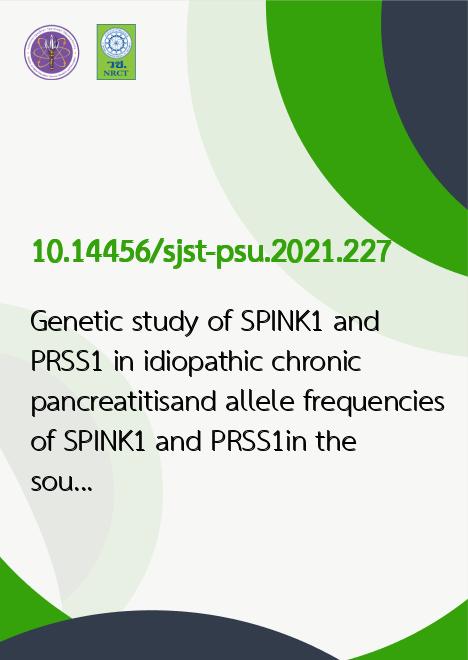
|
Genetic study of SPINK1 and PRSS1 in idiopathic chronic pancreatitisand allele frequencies of SPINK1 and PRSS1in the southern Thai population |
|---|---|
| รหัสดีโอไอ | |
| Creator | 1. Putthimet Lekhakul Promin 2. Wison Laochareonsuk 3. Nisa Netinatsunton 4. Supika Kritsaneepaiboon 5. Surasak Sangkhathat |
| Title | Genetic study of SPINK1 and PRSS1 in idiopathic chronic pancreatitisand allele frequencies of SPINK1 and PRSS1in the southern Thai population |
| Publisher | Research and Development Office, Prince of Songkla University |
| Publication Year | 2564 |
| Journal Title | Songklanakarin Journal of Science an Technology (SJST) |
| Journal Vol. | 43 |
| Journal No. | 6 |
| Page no. | 1736-1742 |
| Keyword | idiopathic chronic pancreatitis, single nucleotide polymorphisms, SPINK1, PRSS1 |
| URL Website | https://rdo.psu.ac.th/sjst/index.php |
| ISSN | 0125-3395 |
| Abstract | Certain cases of chronic pancreatitis (CP) occur without an apparent causative factor, diagnosed as idiopathic CP (ICP).Several studies have reported that ICP was associated with mutations in the SPINK1 and PRSS1 genes, but the studies were notconclusive as these polymorphisms can also occur in healthy individuals. In the present study, we aimed to study the genotypesof SPINK1 and PRSS1. Our study recruited nine ICP patients having no known risk factors. Symptoms relating to ICP wererecorded. Genetic studies were performed in all ICP patients and 230 healthy controls. SPINK1 mutations in cases and controlswere genotyped by genotyping assay. The entire PRSS1 gene was sequenced in all cases and controls to look for any mutations.Statistical analysis of genotypes and minor allele frequencies (MAF) was performed. All of the 9 ICP patients had SPINK1mutations. The SPINK1 N34S heterozygous mutation (MAF 2.17%) was detected in 10 out of 230 controls, while theIVS3+2T>C mutation was not detected in any. PRSS1 mutations were detected in no cases or controls. In summary, SPINK1mutations were associated with ICP. SPINK1 N34S carrier status was found in the general population with low prevalence, whileIVS3+2T>C was rarely found in the controls. |
